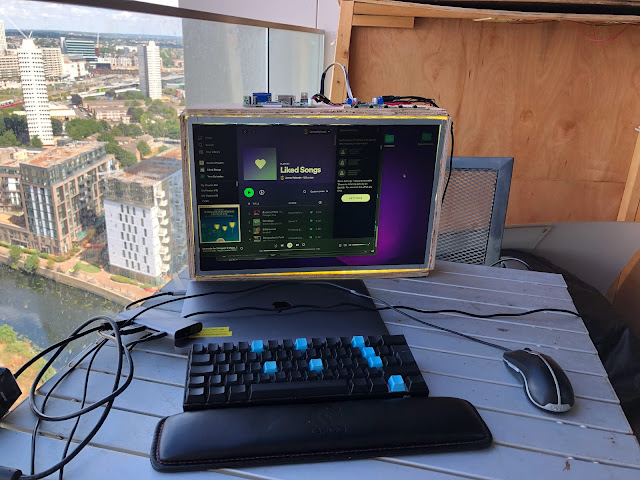Custom work from home desk
As you may have noticed from the other posts on this blog I enjoy making things. I try as much as possible to make useful things, despite what my girlfriend says about the paper mache tower.
In May this year, I was starting a new job and with it coming up to a year in the flat my girlfriend and I were considering if we needed more room.
One of the issues was that we didn’t have a sofa and with both of us working from home, we didn’t really have anywhere to put a sofa.
I was considering starting to go back into the office again, at least part-time and so looked into the idea of a desk that would fold out over a sofa for when I needed it, but that would fold away when I didn’t.
It was quite hard to find something to meet this specification. Most of the fold-away desks just don’t work over a sofa and those that do are too small to work off.
I thought that given the simple nature of a desk as a piece of furniture I would have a go at conceiving of something that would be perfect for my situation.
My dad is a timber merchant and so the cost of the wood was sponsored kindly by Wingham timber. To keep the design simple I decided that a complex folding mechanism was too much.
What I came up with ended up being incredibly useful.
The design is rather simple, there are two panels at right angles which make up the frame.
This fits really well around the sofa.
The screens are attached to the back panel and so don’t need to be put away elsewhere when the desk section gets put away.
This was one of the key points I wanted from my desk. I don’t mind putting the laptop away every day but managing that for two large screens is just a recipe for something getting broken.
The desktop description of the desk is super simple, it’s a single sheet of 25mm plywood.
When designing this I wanted the desk to cantilever so that I didn’t need to worry about additional legs for support to set up.
I ended up pretty adamant that 25mm ply over the scale I was ordering would be stiff enough to not need further support.
I included the support in the design because despite my best efforts to find a modelling solution to predict the flex of the wood there really wasn’t a way I could model if the cantilever would work or not.
The desk slides are some rails cut into the top section of the sides. This works surprisingly well.
One thing I really learned from this project was the realisation that real-world things have width. As simple as that sounds having studied so much unapplied maths rather than more vocational elements, I have always worked with lines of no width.
Two 1m long beams connect at a right angle; how far apart are the non-connecting ends of the beams?
Before this project, I would have answered something along the lines of root 2 meters.
But hang on, how are these beams joined? It would be a pretty strange join if the corner where they joined was just a gap. Maybe it is or there is some reason for them joining at their inner corners but when trying to build something simple, the simplest join is a but join. Simply overlap one by the width of the over and glue or screw through the overlapping into the end of the other.
But now, even though the beams could still be considered end to end, the calculation becomes very different.
I took quite a bit of this forward to my much larger bitcoin mining project.
Image appendix


The best work from home desk setup starts in the part of the house where you choose to place your office. Your work area should be private and away from the main traffic areas in your home, in a place where you can shut the door. This allows you to keep distractions to a minimum. Additionally, there are a lot of different ways that you can work to be more active within a traditional work-space, and an office fit out can help you create an environment for your working area that promotes this type of active working style.Home Office Corner Desks UK
ReplyDelete